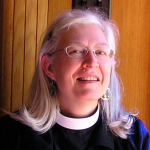Looking up, for what?
When we read the story in Acts about Jesus leaving the apostles for the last time, there are some interesting details. One is that he left them physically. Another is that this copies another prophet’s leaving, the prophet who people have referenced Jesus to a lot – Elijah, who is often referred to as the prophet. Another is what Jesus promises, and finally, their response.
The passage starts out with the disciples asking Jesus, “is this the time you will restore Israel?” They still are caught in the old mindset of what “messiah” means. He does not scream at them “haven’t you heard anything I’ve said?” No, he just says, that’s not for you to know. And then he leaves them. There are two stories I know of about Jesus leaving them at this point. One is the story that is in the Bible. It clearly echoes the story of the bodily ascension of the prophet Elijah. There have been not so subtle references to Jesus being the new Elijah all the way along, and this completes the picture. The other story is that Jesus simply disappears from them – after all, someone who can show up by walking through solid doors can also disappear from them – and that he shows up in India.
My mother went to a Hindu-Methodist wedding, and at the reception, when she said she was a Methodist minister, they said, “oh yes, we know your Jesus.” She was rather startled, and invited them to say more. “Oh yes, we took care of him after the crucifixion.” If you think about it, that makes a lot of sense!
However, it is the response of the disciples that I want to look at here. After Jesus left them with the promise that he would send the Holy Spirit, they prayed. Since observant Jews already pray a lot – and these were all observant Jews – the notation that they devoted themselves to prayer is significant. So I thought we might take a few minutes to look at prayer.
I read this recently, and thought it helpful. “Samuel Wells, a prominent London vicar, has a column in the April 30, 2014 Christian Century, “A Different Way to Pray.” … His starting place is a conversation during the church coffee hour.
After some chit-chat, “your conversation partner takes hold of your forearm, and her tone changes. ‘Say a prayer for my dad, will you? He’s not himself, the dementia’s really kicking in’ … and you say, ‘Of course I’ll pray for your dad. And I’ll pray for you, too.'”
Ah, Wells says, “But then you’ve made a promise. A promise you have to keep. How exactly do you pray for a person in such a situation?” He sketches out three ways to pray — two conventional ones, and one that is more unusual.
The first form, which he calls resurrection, is a call for a miracle. The prayer for dad seeks healing of mind and body, and the hope of a long and fruitful life. Wells admits that this kind of prayer is tempting, but he also acknowledges that “part of you can’t even say the word ‘heal’ because it seems that healing just isn’t going to happen.”
He labels the other conventional form of prayer incarnation. “It is a call for the Holy Spirit to be with your friend and her father … give them patience to endure what lies ahead … and companions to show them your love.” The vicar notes that there’s a dramatic difference between these two kinds of prayer: “while the resurrection prayer expects God to do all the work, this prayer stirs us into action ourselves.” Who is better placed to show God’s love than you, who she turned to as a friend? And it is quite likely that her request for prayer, at least in part, was a plea that she not feel alone in all of this.
Wells then says that there is a third option, beyond a healing miracle or a comforting presence. A prayer of transfiguration looks for something new. “Show my friend and her father your glory, that they may find a deeper truth to their lives than they ever knew, make firmer friends than they ever had, discover reasons for living beyond what they’d ever imagined.” And this kind of prayer also can echo back to the one praying, who comes to recognizes a moment of truth that reveals fresh insights of meaning and purpose. (from: The Rev. Peter Sawtell, EcoJustice Ministries)
When I read this article, which goes on to talk about how we think about the environment and how we need to be praying for it – and obviously he wants us to think about how we might use the third option – it stirred me to think about what I thought about prayer, and what I wanted to teach about prayer.
At one point the disciples asked Jesus to teach them how to pray. This is interesting, because these were folks who were deeply religious already. So why did they need to ask Jesus how to pray? Two reasons come to mind. One is that they might have felt that the way they had learned as children and had kept doing all their lives so far was not as deep as they wanted. Obviously Jesus got a lot of power from his praying, so it would make sense to learn what he was doing! The other reason is that it was a standard request of a religious leader, especially a leader who was giving a lot of new teaching about how to live a Godly life. Jesus had already been teaching them some rather astonishing things about money and status, giving some startling examples of ethical behavior, so asking for direct spiritual advice was totally in line. It would be somewhat akin to coming to a new yoga teacher who you had heard was doing some interesting things. It would be normal to ask about poses and postures and what this teacher thought was important, and not.
So let’s go over this again. What he calls resurrection prayer is the call for a miracle, something where God does the action. The second is incarnation prayer, where we do the action. The third is transformation, looking for something new. Let’s look more closely.
Many people think about prayer as resurrection prayer. We hear about people who pray for miracles, and lo and behold, something happens. We also hear about people who pray for miracles, and the thing they are praying for does not happen. I read about a pastor who after some serious study, decided he was not going to do intercessory prayer any more, because it was just wrong to ask God for miracles like this. He still prays, but not asking for anything to happen.
I would like to suggest a different option than that, one that I think, at least I hope, changes the picture. That is, I will pray for someone in need, I will even ask for something specific to happen. But then, I try to be very open to the response. So I tell people, yes, I expect something to happen, every time I pray for someone, I expect something to happen. However, and this is huge, I try to keep very open about what it is I expect. I never know! It could be physical healing, it could be emotional healing, it could be spiritual healing, it could be a combination of those. What I tell people is that I expect something, and at the same time, I will not promise anything specific. Perhaps this is what Wells is talking about with the transformation prayer.
The second type is incarnation prayer, which speaks to our willingness to be with someone in their pain. When we are willing to be with someone in the midst of their pain, we are standing in for God. It is critical. We call it a ministry of presence. When someone is in pain, knowing that they are not alone is one of the biggest gifts we can give. We know this is true when someone is dying – it is important to be there. You don’t have to do anything much normally, being there, both for the dying person and for the others who are also being present, being there is the gift. There are other times when we open ourselves to recognizing the pain, and realizing that we can do something about it! Then we sometimes have to pray for the courage to do that. We see this when kids realize that there are other people in the area that have no food, and they do something about it. Sometimes we then wonder why we had to wait for the kids to open our eyes about being able to do this.
So back to the reading for one more thing. The angels ask the disciples why they are looking up. Clearly, that is not what they are supposed to be doing! Here is the message to them, and to us: Jesus has come and gone, and now it’s up to us. We need to look around, not to keep looking up. Jesus showed them how this worked – he looked up during his private prayer time, but after that he looked around and dealt with the people. We need to look up, for guidance and for power, but then we need to use that as we look around at the world we are in.
Next week we celebrate Pentecost, which is when we celebrate the disciples receiving the power directly from God, the power to be God’s people in the world. Let us pray this week for that power, and the guidance for how to use it.


